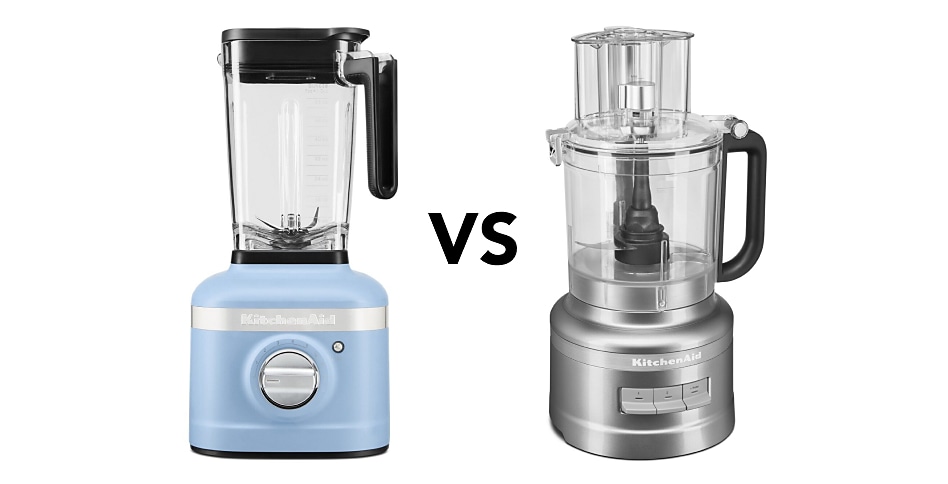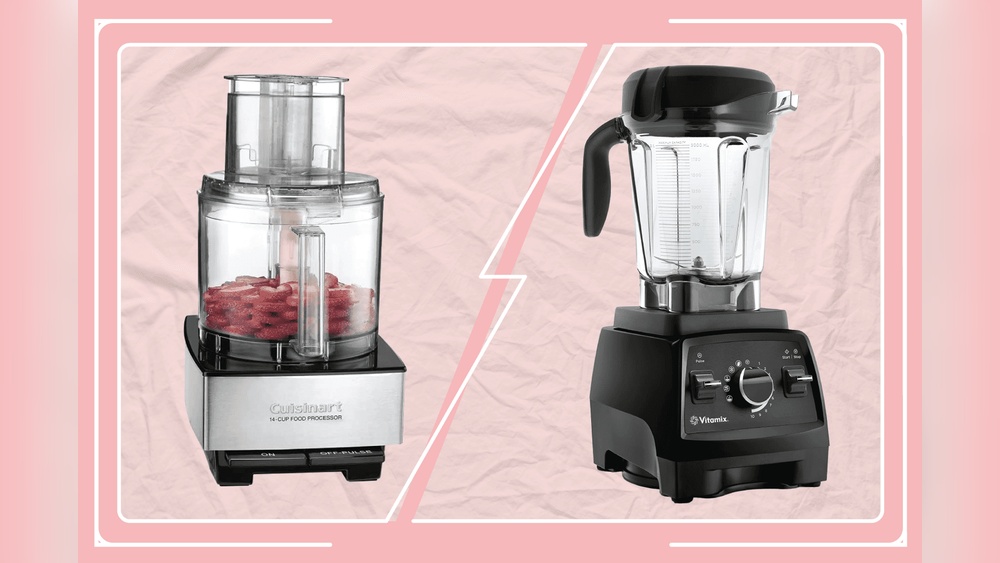Have you ever reached for your food processor only to realize it’s nowhere to be found? Or maybe you’re wondering if your blender can step in and save the day.
You’re not alone. Many home cooks ask themselves, “Can I use a blender instead of a food processor? ” The answer might surprise you. Understanding when and how to swap these two kitchen appliances can save you time, effort, and even a trip to the store.
Keep reading to discover the key differences and smart tips that will make your cooking easier and more efficient.

Credit: www.nytimes.com
Blender Vs Food Processor
Choosing between a blender and a food processor can be confusing. Both are common kitchen tools but serve different purposes. Knowing their differences helps you decide which one fits your cooking needs best.
Key Differences
A blender has tall, narrow blades designed to crush and blend liquids. It works well for smoothies, soups, and sauces. A food processor has wider, sharper blades and a larger bowl. It chops, slices, and grates solid foods more efficiently. Blenders focus on liquid mixing. Food processors handle solid food prep.
Common Uses
Use a blender to make smoothies, milkshakes, and pureed soups. It blends fruits, vegetables, and liquids smoothly. Use a food processor to chop vegetables, shred cheese, and knead dough. It is best for solid ingredients and tasks needing precision. Both machines save time but serve different kitchen roles.

Credit: www.nytimes.com
When A Blender Works
A blender can handle many kitchen tasks well. It works best with liquids and soft foods. Blenders are easy to use and clean. They save time for quick recipes. Knowing when to use a blender helps avoid frustration.
Smoothies And Purees
Blenders blend fruits and vegetables into smooth drinks. They break down soft ingredients fast and evenly. Making purees for soups or baby food is simple. The result is creamy and lump-free. Blenders work well for any liquid-based blend.
Sauces And Dressings
Blenders mix ingredients into smooth sauces. They combine oil, vinegar, and herbs easily. Dressings become thick and well blended. The motor is strong enough for most sauce recipes. Blenders create a fine texture without chunks.
Soft Ingredients
Soft foods like cooked vegetables blend quickly. Blenders handle mashed potatoes and soft fruits well. They are not good for hard or dry foods. Soft ingredients turn into smooth mixtures fast. Use a blender for soft food processing tasks.
Limitations Of Using A Blender
Blenders and food processors look similar but work differently. Blenders are great for liquids and soft foods. They mix and puree well. But blenders have limits when replacing a food processor. These limits affect chopping, handling dry ingredients, and controlling texture.
Chopping And Slicing Challenges
Blenders struggle with chopping and slicing tasks. Their blades spin fast and blend quickly. This makes it hard to get even cuts. Food processors use sharp blades that chop with control. Blenders often turn solid foods into mush. So, chopping vegetables or nuts finely is difficult.
Handling Dry Ingredients
Dry ingredients do not mix well in blenders. Flour, nuts, and grains tend to stick to the sides. Blenders need liquids to create a smooth flow. Without liquid, dry ingredients may not blend evenly. Food processors can handle dry items better. They use a scraping blade to mix thoroughly.
Texture Control Issues
Blenders offer less control over texture. They blend fast and can over-process food. This results in a paste or puree instead of chunks. Food processors allow short pulses for coarse or fine textures. Blenders often miss the mark when texture matters. Controlling the final look of food is harder.
Food Processor Strengths
Food processors handle many kitchen tasks with ease. They offer power and versatility that blenders often lack. Their design suits specific jobs that need strength and precision. These strengths make food processors ideal for various cooking needs.
Dough Making
Food processors mix dough quickly and evenly. The sharp blades cut through flour and butter well. This action creates perfect dough for bread or pastries. Blenders usually cannot handle thick, sticky dough properly. Food processors save time and effort in baking.
Shredding And Grating
Food processors come with shredding and grating disks. These tools slice vegetables, cheese, and nuts fast. The uniform size helps with even cooking and presentation. Blenders do not have attachments for shredding. Food processors make meal prep simpler and faster.
Chunky Chopping
Food processors chop ingredients into coarse pieces easily. They handle onions, peppers, and herbs without turning them to mush. The pulse function gives control over the chop size. Blenders often over-process and create purees instead. Food processors keep texture in dishes like salsa and salads.
Tips For Using A Blender Like A Food Processor
Using a blender instead of a food processor takes some care. The two machines work differently. A blender is good for liquids and soft foods. A food processor handles chopping, slicing, and thick mixtures better.
Here are simple tips to help you use your blender like a food processor. These tips make your tasks easier and your results better.
Pulse Function Use
Use the pulse button to control chopping. Short bursts help avoid over-processing. Pulse in quick, small presses. This method keeps ingredients chunky. It stops your food from turning into paste.
Batch Processing
Work in small batches. Too much food can jam the blender. Smaller amounts chop more evenly. Stop and shake the blender jar often. This moves food around for better cutting.
Blade Attachments
Check if your blender has extra blades. Some blenders come with chopping or slicing attachments. These work better for dry or hard foods. Using the right blade helps mimic a food processor’s work.

Credit: www.kitchenaid.com
Best Blender Models For Food Processing Tasks
Many blenders can handle food processing tasks well. Some models offer power and features that make chopping, mixing, and pureeing easy. Choosing the right blender depends on the type of food processing you need.
Here are some blender types to consider for these tasks.
High-powered Blenders
High-powered blenders have strong motors that chop and blend tough ingredients. They can crush ice, nuts, and hard vegetables quickly. These blenders work well for making dough or thick sauces. Power helps with smooth and even results.
Blenders With Multiple Speeds
Blenders with multiple speeds give better control over texture. Low speeds help gently chop soft ingredients. High speeds handle tougher foods and purees. Variable speeds let you create chunky or smooth mixtures easily.
Versatile Attachments
Some blenders come with extra tools for food processing. Attachments like chopping bowls or slicing discs expand their uses. These make your blender more like a food processor. They save space and add convenience in the kitchen.
When To Choose A Food Processor Instead
Choosing between a blender and a food processor can be tricky. Both tools have their uses in the kitchen. A food processor handles some tasks better than a blender. It offers more control and power for certain jobs. Knowing when to pick a food processor helps get the best results.
Frequent Heavy-duty Tasks
Food processors are built for tough jobs. They can chop, shred, and mix dense ingredients easily. Regularly handling nuts, dough, or hard vegetables needs a food processor. Blenders may struggle or overheat with these tasks. The food processor’s strong motor and sharp blades save time and effort.
Large Quantity Prep
Food processors have larger bowls than blenders. This makes them ideal for preparing big amounts of food. Cooking for a family or a party requires more volume. A food processor can chop or mix large batches quickly. Using a blender for big tasks means working in small batches repeatedly.
Precision Cutting
Food processors offer better control for cutting tasks. They can slice or dice ingredients evenly. This helps with recipes needing uniform pieces. Blenders blend everything into a smooth texture. Food processors keep the shape of ingredients intact. This precision improves the texture and appearance of dishes.
Frequently Asked Questions
Can A Blender Replace A Food Processor For Chopping?
A blender can chop, but it is less precise than a food processor. Food processors handle thick or dense ingredients better for even chopping.
Is A Blender Good For Making Dough Instead Of A Food Processor?
Blenders are not ideal for dough because they lack proper mixing power. Food processors mix dough more evenly and efficiently.
Can I Use A Blender To Shred Vegetables Like A Food Processor?
Blenders can shred vegetables but not as uniformly. Food processors offer better control and consistent shredding results for vegetables.
Will A Blender Puree Foods As Effectively As A Food Processor?
Blenders excel at pureeing liquids and soft foods. Food processors handle chunky purees better and offer more texture control.
Conclusion
A blender can work for some food processor tasks. It blends liquids and soft ingredients well. But it may not chop or slice as evenly. Blenders often struggle with thick dough or firm vegetables. Using the right tool saves time and effort.
Choose a food processor for heavy chopping or mixing. Pick a blender for smoothies and purees. Knowing their limits helps you cook better meals. Both have a place in the kitchen. Use each wisely to get the best results.

